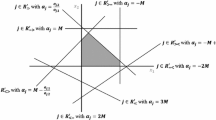Abstract
We introduce a new network simplex pivot rule for the shortest path simplex algorithm. This new pivot rule chooses a subset of non-basic arcs to simultaneously enter into the basis. We call this operation a multiple pivot. We show that a shortest path simplex algorithm with this pivot rule performs O(n) multiple pivots and runs in O(nm) time. Our pivot rule is based on the new concept of a pseudo permanently labeled node, and it can be adapted to design a new label-correcting algorithm that runs in O(nm). Moreover, this concept lets us introduce new rules to identify negative cycles. Finally, we compare the network simplex algorithm with multiple pivots with other previously proposed efficient network simplex algorithm in a computational experiment.
Similar content being viewed by others
References
Ahuja, R., Magnanti, T., Orlin, J.B.: Network Flows. Prentice Hall, New York (1993)
Akgul, M.: Shortest paths and the simplex method. Technical Report, Department of Computer Sciences and Operations Research Program, North Carolina State University, Raleigh, NC (1986)
Bellman, R.: On a route problem. Q. Appl. Math. 16, 87–90 (1958)
Cherkassky, B.V., Goldberg, A.V., Radzik, T.: Shortest paths algorithms: theory and experimental evaluation. Math. Program. 73, 129–174 (1996)
Cunningham, W.H.: Theoretical properties of the network simplex method. Math. Program. 4, 196–208 (1979)
Dantzig, G.B.: Discrete-variable extremum principles. Oper. Res. 5, 266–277 (1957)
Dial, R., Glover, F., Karney, D., Klingman, D.: A computational analysis of alternative algorithms and labeling techniques for finding shortest path trees. Networks 9, 215–248 (1979)
Ford, L.R.: Network flow theory. The Rand Corporation Report P-923, Santa Monica, Calif (1956)
Goldfarb, D., Jin, Z.: An O(nm)-time network simplex algorithm for the shortest path problem. Oper. Res. 47(3), 445–448 (1999)
Goldfarb, D., Hao, J., Kai, S.R.: Efficient shortest path simplex algorithms. Oper. Res. 38(4), 624–628 (1990)
Goldfarb, D., Hao, J., Kai, S.R.: Anti-stalling pivot rules for the network simplex algorithm. Networks 20, 79–91 (1990)
Minty, G.J.: A variant on the shortest route problem. Oper. Res. 6, 882 (1958)
Moore, Z.F.: The shortest path through a maze. In: Proceedings of the International Symposium on Theory of Switching, Part II, pp. 285–292 (1957)
Orlin, B.: On the simplex algorithm for networks and generalized networks. Math. Program. Study 25, 166–178 (1985)
Subramani, K., Kovalchick, L.: A greedy strategy for detecting negative cost cycles in networks. Future Gener. Comput. Syst. 21(4), 607–623 (2005)
Author information
Authors and Affiliations
Corresponding author
Rights and permissions
About this article
Cite this article
Sedeño-Noda, A., González-Martín, C. New efficient shortest path simplex algorithm: pseudo permanent labels instead of permanent labels. Comput Optim Appl 43, 437–448 (2009). https://doi.org/10.1007/s10589-007-9144-7
Received:
Revised:
Published:
Issue Date:
DOI: https://doi.org/10.1007/s10589-007-9144-7




